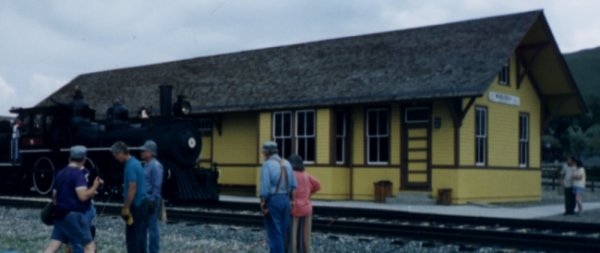The mining boom brought about
by the discovery of gold and silver at Tonopah and Goldfield
immediately after 1900 did much to expand shipments of such indigenous
agricultural products as hay, grain and potatoes from Mason Valley.
The tremendous increase of freight out of Wabuska influenced the S. P.
to replace the original C&C depot with a larger station in 1906. They
also added a freight shed. This agricultural boom coupled with the
highly active development of the bluestone deposits by the Nevada
Douglas, Mason Valley and Bluestone mining companies soon led to the
construction of several ore processing facilities. To economically
transport the ore from the mines located in both Smith and Mason
valleys, the Nevada Douglas Copper Co., the area’s principal developer,
surveyed and then contracted for the construction of a standard gauge
railroad, starting at Wabuska, in 1909. The S. P., now the owner of
the old C&C, in the meantime had broad gauged its line in 1906.
Resembling a gigantic letter “J,” the route of the Nevada Copper Belt
Railway was completed to Ludwig three years and 37.8 miles later.
Soon after the NCB began
service in 1912, the railroad’s first three engines and cars were kept
active hauling up to 750 tons of ore per day. Wabuska was indeed a
bustling place as many freight teams arrived and departed daily to and
from the smaller mining camps of Ramsey, Buckskin and others. Copper
was KING – for a while – along with gold and silver. Then, as
most mining booms seem to do repeatedly, in face of declining prices of
metal, the economy hit the skids. The region suffered since the three
major companies, i.e., Nevada Douglas, Mason Valley and the Bluestone
mines constituted the principal sources of traffic for the NCB. There
was a brief flurry of activity in the late 1910s and again in the
1920s.
According to historian David
F. Myrick: “Passenger service on the NCB was both transilient and
ephemeral …” except between Wabuska and Thompson (site of the Mason
Valley Mill Co.’s huge smelter) where service could be considered
normal. In addition to what little revenue was earned from hauling
freight, the company’s cashbook recorded an occasional picnic excursion
from Ludwig as well as from the other end of the line at Wabuska and
Yerington. The destination was Wilson’s Canyon. The two Hall-Scott
gasoline-powered motor cars often provided this service and on some
occasions hauled “as many as three or four freight cars in addition to
their human cargo.”
Revenues continued to dip,
prompting the owners of the Nevada Copper Belt to petition for
abandonment. March 24, 1947 was the last day of operation.
Apparently, business at Wabuska depot continued sufficiently until
shortly before Sept. 1, 1979, when the Southern Pacific closed the
seventy-three year-old structure. Following its gift to the Nevada
State Museum in 1982, the eighty-foot long depot was moved intact to
the Railroad Museum at Carson City in 1983. During the next four
years, depending on time and funds, the depot underwent a complete
renewal to reflect its appearance of the 1910s. Not-withstanding the
addition of a number of mandatory safety features as well as a
telephone and an electronic cash register, the Wabuska depot is back in
business – serving as a busy railroad station once again.
In late 2003 the
depot received a new wooden platform to facilitate the loading of our
guests on the steam trains and the motor cars.

Return to Previous Page
Modified
Monday December 08, 2008




![]()

